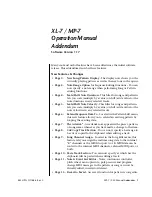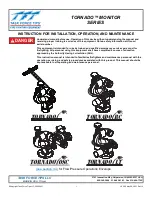
Owners Manual - Revision 1.5
8
Using your parachute is most obviously your last
option. Be familiar with your particular aircraft
escape procedures and practice them often until
they are second nature. You must be able to
react instantly to save valuable time, altitude,
and your life. If you don’t have an emergency
egress procedure for your aircraft the best time
to develop one is before your next flight.
Once you have exited the aircraft, you will most
likely be tumbling. The most important thing to
do is pull the ripcord immediately and throw it
away. It takes approximately 2-3 seconds for the
parachute to fully deploy. Altitude used for
complete deployment at terminal velocity is
approximately 300-500 feet. That is not the
altitude to initiate emergency procedures, but the
distance required for deployment and opening.
Once the parachute is open, it is time to think
about steering. Guiding an open parachute
safely to the ground is a two fold operation. The
newer parachutes on the market today are
steerable and they have control toggles installed
on each riser. To turn left, pull down on the left
toggle and to turn right pull down on the right
toggle. The forward speed of a round parachute
is approximately 3-5 MPH and the 360 degree
turn rate is about 6-10 seconds. First, use this
forward speed and control of heading to maneu-
ver away from any life threatening obstacles
such as power lines or water hazards. Second,
use the forward speed of the canopy to reduce
ground speed at landing; by facing the canopy
into the wind. Your rate of decent will increase
during a turn, be careful not to make radical
turns below 100 ft. AGL. Make only small
corrections below that altitude to maintain
heading. Square parachutes have a much higher
turn rate, faster forward speed and are more
manuverable. They require that you face into
the wind and flare (similar to an aircraft) for
landing. Handled properly they land much
softer than a round parachute.
Landing is the final act in the bailout and it is
important to follow these instructions in order to
avoid injury. Steer into the wind and don’t
attempt any radical turns below 100ft. Look out
towards the horizon and hold your knees and
feet together tightly. Keep your knees
slightly bent with your toes pointed down.
Put your arms above your head holding on to
the risers and as you contact the ground, roll
in the direction you are moving when you
land.
Try to avoid obstacles if possible. If you are
going to land in a tree or power lines keep
your knees and feet together and present the
smallest possible profile to the obstacle.
Also, turn your face to the side. In the event
of a water landing, prepare for a regular
landing except land downwind so your
parachute will land out in front of you and
not on top of you. Unfasten the leg and
chest straps and swim upward away from the
parachute so as not to get entangled in the
lines. If you land during high winds, after
landing roll onto your back and deflate the
parachute by pulling in one; or two adjacent
lines hand over hand to spill the air from and
collapse the canopy. Also jettison the
parachute harness and cover the parachute
as to not re-inflate it. There is a lot to
remember in a bailout so it is important that
you plan ahead and review your plan of
action in case of an emergency.
Parachute systems may seem like expensive
cushions that we carry needlessly on our
back or sit on without regard. That cushion,
however is a highly specialized life saving
device and is vitally important to your air
safety. Get to know your parachute system
and soon you will realize what an ally that
cushion can be and why you should never
leave the ground without it.
* * * * *
Summary of Contents for SOFTIE 180 Back
Page 1: ...OWNER S MANUAL AND PACKING INSTRUCTIONS EMERGENCY PARACHUTE SYSTEMS...
Page 2: ...THIS PAGE INTENTIONALLY LEFT BLANK...
Page 8: ...Owners Manual Revision 1 5 6 1 0 General Information...
Page 11: ...9 Owners Manual Revision 1 5 1 2 Softie Letter of TSO Authorization...
Page 14: ...Owners Manual Revision 1 5 12 2 0 User Information...
Page 19: ...17 Owners Manual Revision 1 5 THIS PAGE INTENTIONALLY LEFT BLANK...
Page 20: ...Owners Manual Revision 1 5 18 3 0 Compatibility of Components...
Page 25: ...23 Owners Manual Revision 1 5 THIS PAGE INTENTIONALLY LEFT BLANK...
Page 26: ...24 Owners Manual Revision 1 5 4 0 Rigger Information...











































